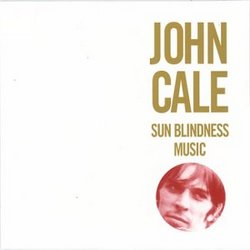| All Artists: John Cale Title: Sun Blindness Music Members Wishing: 4 Total Copies: 0 Label: Table Of Elements/Ada Release Date: 1/1/2002 Genres: Alternative Rock, Special Interest, Rock Styles: Experimental Music, Progressive, Progressive Rock Number of Discs: 1 SwapaCD Credits: 1 UPC: 806501107527 |
Search - John Cale :: Sun Blindness Music
CD Details |
CD ReviewsCale's Minimalist Debut aco | USA | 04/10/2008 (5 out of 5 stars) "Contrary to some reviews I have come across which insinuate that John Cale's Sun Blindness Music was an attempt at emulating Lou Reed's Metal Machine Music, SBM was in fact recorded around ten years before the equally jarring yet considerably less interesting MMM. If anything, Reed was emulating Cale. That being said, on with the review.
Simply put, Cale's SBM is a masterpiece of minimalist art. Recorded independently during Cale's tenure as the bassist for The Velvet Underground (in the case of track 2, Summer Heat, slightly earlier), Sun Blindness Music is everything it strives to be and nothing more. This is not dinner table music, folks. Those who buy it expecting something to serenade guests with will, most likely, be sorely mistaken. Yes, the music is cacophonous. Yes, it requires an open mind. But damned if it's not charming. Clearly Cale has learned from the master of minimalism himself, John Cage (He was Cage's student at university, after all). SBM is the first part in a trilogy assembled recently by the independent label Table of the Elements; it precedes the albums Dream Interpretation and Stainless Steel Gamelan. Track 1 opens simply. The music begins and that's it for nearly three quarters of an hour. No hook, no fade. The 43 minute title track, Sun Blindness Music, is aptly named. It is tantamount to an audio translation of how your brain feels in a hot car with the windows rolled up on an extremely bright day. The track is a simple and highly improvisational piece for unaccompanied Vox organ. Cale patiently tests the boundaries of sound by subjecting a single chord to an ever-increasing array of pressures and timbres, sometimes for minutes at a time. The volume rises and falls, seemingly, along with the player's emotions. The sound can go from a noisy fever pitch to something barely noticeable within seconds. Melody is nonexistent. The singularity of the organ makes Sun Blindness Music a deceptively simple piece, which is possibly the root of most critics' protests. But in this singularity lies a very clean, very deliberate sound which would be lost in the mix if played by multiple instruments (the main problem with Metal Machine Music). Sun Blindness Music is clearly the most challenging track on the album, and it is easy to see why - if not for the inordinately long running time (the longest in the trilogy) then for the sheer attention required to really `get' it. As is sadly the case in most modern art, the initial reaction of the viewer or listener is to dismiss it offhand as something amateur or `too easy.' Well, Cale clearly `gets' it; he knows what he's doing. Whether or not the listener interprets it properly is another matter. Track 2, recorded in 1965 and the earliest piece here, continues with the theme of uncomfortable brightness with the 11 minute `Summer Heat.' After the relentless array of sharp noises emitted during `Sun Blindness Music,' `Summer Heat' may seem like something of a relief. It is a considerably simpler piece, if such can be the case, but also less interesting. Still, `Summer Heat' is not without its charms; after all, it is difficult to play second string to a brilliant 43 minute opener. Instead of the blinding screech of the Vox organ in track 1, a fuzzy guitar churns out an improvisational riff for 11 minutes. The result is a decidedly under-produced sound which would later resurface in 1968 in The Velvet Underground's infamous `Sister Ray,' arguably the greatest song in their repertoire. The charm lies in this garage-improvesque sound. Compared to the clean and studio-controlled sound of `Sun Blindness Music,' `Summer Heat' is a basement tape. Track 3 returns Cale to a crisper sound. The linear notes on the album list the instrumentation of `The Second Fortress,' the third and final track on the album, as `electronic sounds.' This is basically Cale returning to his precious Vox organ and playing yet another series of sounds a-la `Sun Blindness Music.' But instead of reproducing the bare-bones, unrelenting sound of SBM, Cale takes his music and incorporates a recording device, which he then uses to carefully layer, reverse, speed up, and slow down sound upon sound until what is left is a seemingly disembodied, dissonant drone which lasts for 10.5 minutes. If Lou Reed got his inspiration for Metal Machine Music from anywhere, it would not be surprising if he'd listened to `The Second Fortress' a couple of times. But while MMM is an experiment of layering wildly different and clashing sounds, TSF is an amalgam of extremely subtle, barely noticeable changes. In some ways this track is more difficult to comprehend than `Sun Blindness Music,' due to this simplicity. Imagine listing to nothing else but the inner workings of your computer, amplified, for ten minutes. 1967's `The Second Fortress' captured this exact sound perfectly 20 years before it could easily be comprehended." |

